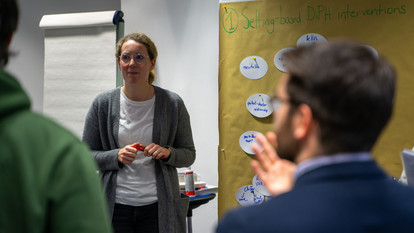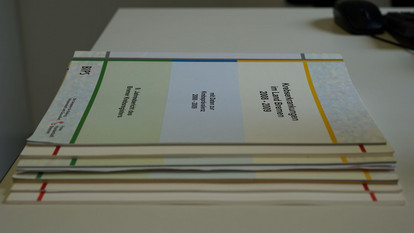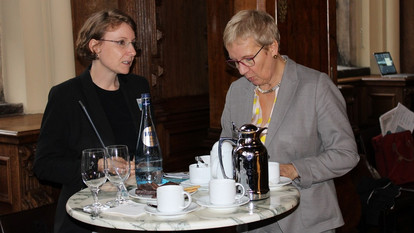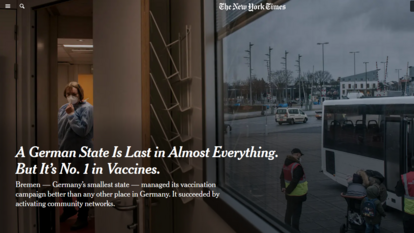The Leibniz Institute for Prevention Research and Epidemiology – BIPS has developed a comprehensive transfer strategy to ensure that the findings from its research are discussed by and disseminated to a wider audience, i.e., that its scientific findings are translated into practice and ultimately have a positive impact on the society. BIPS' transfer strategy is closely linked to its research strategy and is based on the Leibniz Association's transfer mission statement. The nine transfer paths introduced by the Leibniz Association were adapted to the specific needs of BIPS. To measure the success of this strategy, BIPS mainly relies on indicators that allow assessing the impact of its research results on society and continuously enhancing it.
The BIPS covers the entire cycle of epidemiological research, from research methods development and identification of disease causes to intervention and implementation research. For BIPS, research and transfer are closely interconnected, and knowledge transfer is an integral part of the institute’s mission.
The main question that guides the institute’s knowledge transfer is: What keeps people healthy and what protects them from disease? To more strongly reflect the growing importance of knowledge transfer, BIPS formed a Communications and Transfer Staff Office to bundle all corresponding activities. The team advises and trains scientists on knowledge transfer, develops its own formats and promotes the long-term transfer strategy.
Depending on the specific message to be disseminated or transfer aims to be achieved, BIPS addresses different target groups: (1) expert audience from epidemiology, public health, and medicine, (2) politics, professional associations, and institutions in the health care sector, (3) media and the general public, and (4) potential cooperation partners and funding agencies.
Team Transfer & Communication
Rasmus Cloes
Public relations
(Team leader)
Contact:
Tel: +49 (0)421 218-56780
Fax: +49 (0)421 218-56761
Email: cloes(at)leibniz-bips.de
Teresa Alberts
Officer for science communication NFDI4Health
Email: alberts(at)leibniz-bips.de
Sebastian Budde
Digital media officer
Email: budde(at)leibniz-bips.de
Mario Vivone
Media computer scientist/Digital media
Email: vivone(at)leibniz-bips.de
Transfer path 1
Cooperation with industry
Transfer path 2
Spin-offs
Transfer path 3
Intellectual property
Transfer path 4
Standardization and norming
Transfer path 5
Transfer via minds
Transfer path 6
Infrastructure services
Transfer path 7
Policy advice
Transfer path 8
Active citizen participation
Transfer path 9
Public relations
Strategic orientation for the future
BIPS focuses on those paths that best fit its research strategy and that are most efficient in transferring its findings in epidemiology and public health from the research arena to the society. It considers the transfer paths 4 on standardization and norming, 5 on transfer via minds, 6 on infrastructure services, and 7-9 on science communication to be particularly relevant to achieve its mission. However, it has become apparent in recent years that especially transfer path 7 (policy advice) supported by path 9 (public relations) is very efficient in bringing BIPS topics into the public discourse and into political decision-making processes. For this reason, policy advice will be further expanded in the future. This reflects the understanding that the environmental and regulatory conditions are particularly important to personal choices for a healthy lifestyle.
How can the impact of transfer be measured?
There have been increasing demands to measure the impact of research and transfer activities. Consequently, research institutes are required to develop a set of indicators for evaluating the various transfer activities and to build up structures to map these activities (as, e.g., proposed by the EU Results Framework (EURF) or the Global Europe Results Framework (GERF)).
To measure the impact of transfer activities, an approach that combines quantitative and qualitative methods is commonly considered. The quantitative domain is usually divided into input- and output-related indicators. In this context, input-related indicators include the resources made available for transfer activities, such as employees contributing to transfer activities or technical aids. Output-related indicators include indicators on political and social advice (number of statements, expert opinions, position papers, memberships in national and international advisory bodies) or on social media presence as well as the number of organized events (e.g., stakeholder and other transfer workshops) or published press releases.
BIPS has long been reporting on these quantitative indicators for its transfer activities mainly via the German Pact for Research and Innovation. This system has proven successful with its quantitative key figures and will thus be continued in the future.
Strategic orientation for the future
BIPS plans to add a qualitative level to the quantitative metrics already in use. For this purpose, it plans to describe the impact of its transfer activities and thus of its research results by so-called impact case studies. Impact case studies are a way to show the positive changes or benefits that a particular research project or initiative has had on society. For this, a clear, coherent narrative that explains the relationship between research and its impact, and the nature of the benefits arising is summed up in a short paper. BIPS will initially develop a small set of impact case studies for core projects, orienting the structure of these studies on the guidelines of the Research Excellence Framework.
Additional information
Authors: Rasmus Cloes, Hajo Zeeb
Planned revision date: January 2025









